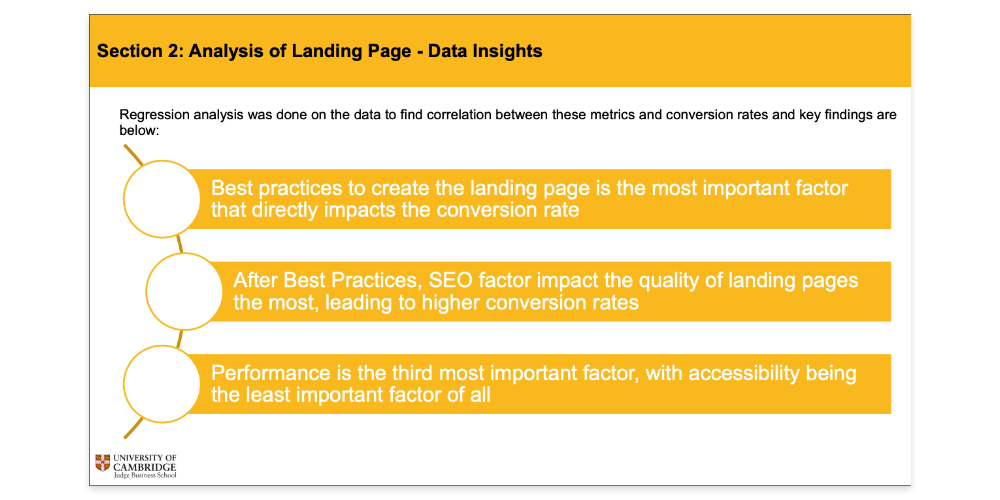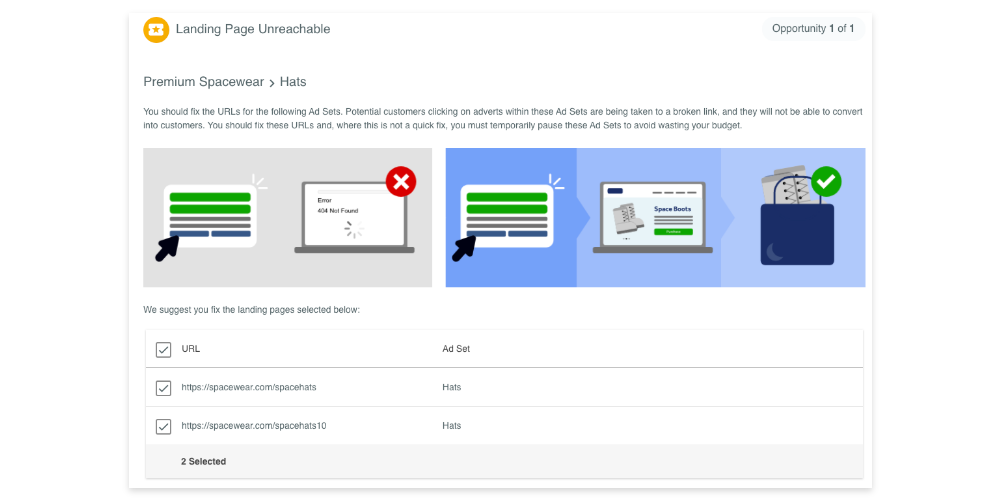This summer, the Adzooma team was joined by Cambridge students Sunil Grewal, formerly of Amazon, Akanshaa Khare formerly of the World Health Organisation, as well as 2020 Women Of The Future Awards nominee Srishti Warman.
They undertook a variety of research projects, which we’ve written full reports of. You can find their other findings here:
- What makes online marketing work – An Adzooma & University of Cambridge Study
- A background look into how and why we ended up working with the University of Cambridge
- Why Your Content Strategy Is So Crucial To PPC Success
- The Cambridge team took a deep dive into sentimentality to help shape how you write your PPC ads
- How To Select The Best Digital Marketing Channel For Your Business
- We drove into our reams of data to determine whether Microsoft, Google and/or Facebook Ads is the best marketing channel for you
One of the topics they looked at was based on a simple question: What makes a landing page convert?
Now, there are parts of a landing page that you’ll hear marketers talk about time and time again. You need relevant keywords to bring in the right kind of traffic to your website. You need good copy to sell your product and convince customers to cross the line.
All of this is still true and you can read more advice about it in our guide to creating landing pages that convert better than your website.
But it’s not the only contributing factor. And so, part of the research between Cambridge University and Adzooma was to understand how website quality can have an impact on conversion rates.
*Disclaimer – All campaign data provided to study participants was selected at random and anonymised.
Increasing conversions with landing page performance
For this study, the Cambridge students were given access to an extract of campaign data from Microsoft, Google and Facebook advertising that was being managed through Adzooma. These businesses were selected at random from a variation of industries to keep the study unbiased.
In terms of landing page conversions, one of the tools that was invaluable for this research was Lighthouse. The Google automation tool checked the quality of the landing pages from the data sample in terms of performance, accessibility and other best practice guidelines, delivering numerical values for each key area. The students then compiled this data, measuring performance scores against conversion data.
Out of all the data submitted, only 5% of websites came back with a perfect score. For 95% of businesses in the sample, there was room for improvement in their landing pages.
When analyzing the data, the Cambridge students didn’t just find a direct correlation between landing page performance and increased conversion rate, but also what aspects of landing page quality are the most important.

We’ll outline all of these aspects in order of importance, starting with best practices.
1. Best practices
Google Lighthouse best practices check to see that your website is built and formatted in the best way. They don’t check the content or copy of the page. If you’re interested in seeing the best practices for this, head further down the article.
Some of the checks that run under best practice are:
- Using HTTPS
- Displaying images with correct aspect ratios
- Serving images with an appropriate resolution for clarity
- Avoiding a request for location when the page is loading
Most of these practices are about building trust with the user. An HTTPS is a secure protocol connection for users that are becoming standard for websites, whether or not sensitive data is shared. If your landing page is driving users to a payment gateway or collecting information, users will need the security for extra peace of mind.
Similarly, if a notification box pops up asking for someone’s location without context, users will become suspicious or mistrustful of the website and why they would possibly need this information. If you operate a landing page that has users search for the nearest store, make sure this request is tied to the action and not page load.
More trust means more conversions.
Out of all the landing pages analysed for this research, 0% of them had a perfect score for this particular section.
2. SEO
The Google Lighthouse SEO section makes a number of checks to see if your page is optimised for Search Engines.
This includes factors such as:
- Having meta titles and meta descriptions
- Making sure the page is indexable with a valid robots.txt
- Ensuring that the links used on the page are crawlable
The Cambridge researchers found that 3. SEO factors are the second most important quality element that impacts conversion rates.
Considering that organic clicks are not usually the main source of traffic towards landing pages, this one may come as a surprise for having a direct effect on conversion rates.
SEO and CRO are different disciplines, but they overlap in key areas of putting users first and providing quality content that answers questions. Therefore, making sure that your page is optimised for SEO is a good way of ensuring that your page is optimised for users generally.
3. Performance
Performance for the Google Lighthouse refers to how well the page physically performs, rather than any conversion goals or metrics you might be personally monitoring in Google Analytics.
It checks factors such as:
- Load time, which can have a direct impact on conversions
- Ensuring there’s no unused JavaScript or elements on the page slowing it down
- Avoiding excessive DOM sizes to reduce memory usage
I’m sure you’ve heard stats about how load time can affect conversions and performance before. But to hammer home the point of why this is so important, let me remind you that 40% of customers won’t wait more than 3 seconds for a website to load.
1, 2, 3. If your page takes longer than that to load, nearly half your audience has already left.
Even a 1-second delay on your website can reduce customer satisfaction by 16%. Even the BBC loses an additional 10% of users for every extra second it takes for its site to load.

4. Accessibility
Google Lighthouse accessibility checks how accessible your page is. Accessibility on the web is massively important for conversions and usability as if your site isn’t accessible for all, you’re automatically discounting part of your audience.
It’s equivalent to building your store on top of a steep set of stairs with no handrail. Not everyone will be able to climb them and make it to that final stage.
Although Google Lighthouse doesn’t provide a complete check of a website’s accessibility, it does check for factors such as:
- Making sure images have alt attributes for visually impaired
- Any lists are formatted correctly for screen readers
- Buttons have accessible names
In addition to these checks, you will want to think about how accessible your landing page is on different devices. Does it work as well on mobile as it does on desktop? Can someone load it on older browsers and systems?
The more accessible you make your landing page, the wider you open the door for people to convert.
What other factors influence landing page conversion rate?
Landing page quality has an impact on conversion rates, but it’s not the only factor going on. Customers aren’t going to buy your project just because the website has a great build.
These are some of the other factors you need to consider to improve landing page conversions.
1. Content
Content is the big one here. All the words, images or videos on the page should all be working together to guide your user to take action.
If users are landing on your page and you’re not experiencing any technical problems highlighted above, then it’s your content that will need looking at.
The best content will:
- Be engaging and relevant to your target audience
- Answer any questions or reassure any doubts about your product. Give them exact sizes or dimensions, mention your return policy, talk about your guarantees. You want to remove any hesitations your users will have and give them total faith in your product.
- Promote your USP. Your USP (Unique Selling Point) is the thing that makes your business different from the rest. It’s the reason users should buy from you, and not from your competitors. It’s that extra ‘Thing’ that will help you beat the competition and it should be there, loud and clear in your content.
Not a writer? There are thousands of freelancers or agencies that can turn your copy into solid gold. Find exactly who you’re looking for here.

2. CTAs
A CTA (Call To Action) is a short, direct message that tells your users what action they should take. Most commonly, they appear as buttons such as “Buy Now” “Add to basket” or “Book your place”.
CTAs are a fundamental part of a high converting landing page because they push users into converting. Without them, you could have an excellent page with a brilliant copy. Your users could be hanging off every word and have their credit card ready to sign up right now. But without a CTA… they don’t know what to do.
If you can’t direct them at that exact moment, you’ve lost them.
3. The PPC to landing page journey
Landing pages don’t work in isolation. Users don’t stumble across them by accident – there are campaigns or PPC adverts that are guiding users to that page.
To improve conversions, you need to make sure that every stage of your user journey is lined up and working together.
If people are clicking on an advert promoting the softest, comfiest mattress in the world, they don’t want to be taken to a landing page advertising every mattress type that your business offers. They want a relevant, ultra-targeted and specific page promoting your softest boys.
To help identify if this is a problem with your landing page, you’ll want to use PPC software such as Adzooma. When linked up with your Google Analytics, it will be able to identify what campaigns are performing well and getting a lot of clicks, but aren’t converting so you can go in and make necessary changes. It’s free to use for as many accounts as you wish.
Check the quality of your landing page
Want to check the quality of your own landing page?
There are dozens of tools that you can use to get a handle of your own website. To get you started, we’ve listed some tools that you can use to check your performance.
Google Analytics
If you’re not already using Google Analytics, then it’s time to change that. This tool will show you how users are using and interacting with your website, giving key metrics such as bounce rate for your landing pages.
Lighthouse
As explored earlier, Lighthouse can provide key stats on the quality and performance of your landing page and checks that you might be failing.
To run your own Lighthouse check, load up your landing page. Then, right-click and choose the ‘inspect’ option. This will bring up a screen with a lot of code, but don’t worry – we’re not going through that. You just need to click Lighthouse at the top of this screen.
If you can’t see it listed, press the >> button.

Once loaded, click the ‘Generate Report’ button and wait for your results to come back.
Semrush
When you enter a URL into Semrush, you’ll be able to access reports and insights for SEO, PPC, Social Media, Content Marketing and Market Research. Although not all of these will be immediately useful for checking your landing page quality, you will be able to see:
- Keyword analysis and ideas for your PPC campaigns or to gain more organic traffic
- Competitors SEO/PPC strategy to see if there are any gaps you can target
- Questions that your audience might be asking – and that you can address with the content on your landing page
To access all of these features, click here for your 14 day free trial.
Screaming Frog
Screaming Frog is another tool that, like Semrush, is primarily based around SEO. But, as we discussed earlier, knowing the SEO shortcomings of your landing page can help you build a better experience overall, increasing the number of conversions.
Screaming Frog provides in-depth SEO reports and site maps which aren’t necessarily needed for your landing page. However, some checks such as broken links page titles and metadata checks will come in handy.
You’ll be able to test for these checks using the free version of their tool.
Adzooma
What can we say, we left the best for last. The Adzooma platform is designed to make your PPC management easier and more efficient. AND, we have just launched Adzooma Plus. Adzooma Plus is more than just an add-on or paid platform. It’s your new growth partner to help take your business to the next level.
It comes with all the features of the free Adzooma Essentials platform, PLUS more advanced tools, insights and optimizations specifically designed to achieve results.
Our landing page opportunities check factors such as your:
- Page speed, as slow websites can kill sales. The longer it takes to load, the more customers you’ll lose.
- Landing page experience, which is a measure of the quality of the page that your customers are taken to. If a page isn’t relevant, is hard to navigate or doesn’t provide the right information, it will be seen as poor quality. Poor quality landing pages don’t just harm your sales, but also impact where your adverts are placed in the search results page.
- Mobile experience, which measures how user friendly your landing page is.
- Broken landing pages or errors, giving you reassurance that your pages are always working.
What’s more, we’re also going to use the results from the Cambridge study to improve the platform and bring you more Opportunities to improve your landing pages.

You can access these features and more for free. Sign up today.
Need a whole new landing page?
Found that your landing page isn’t up to scratch and need to rebuild? Or just want an extra hand increasing conversions?
Head over to the Adzooma Marketplace. We’ve got all the web developers, CRO agencies and copywriters you’ll need to increase your conversions and draw in more profit.
Find what you’re looking for on the Adzooma Marketplace.




